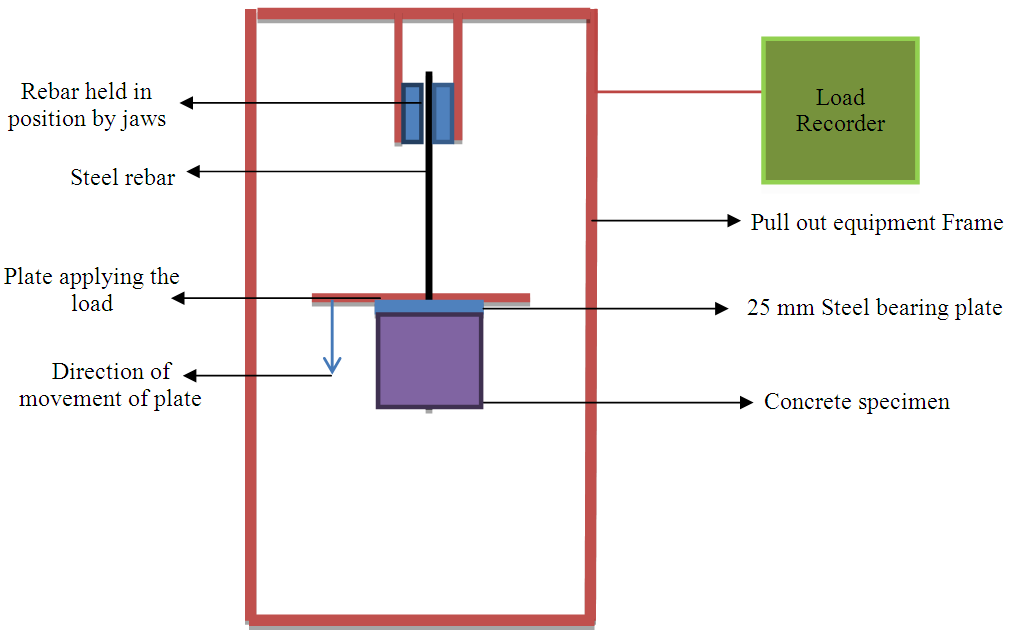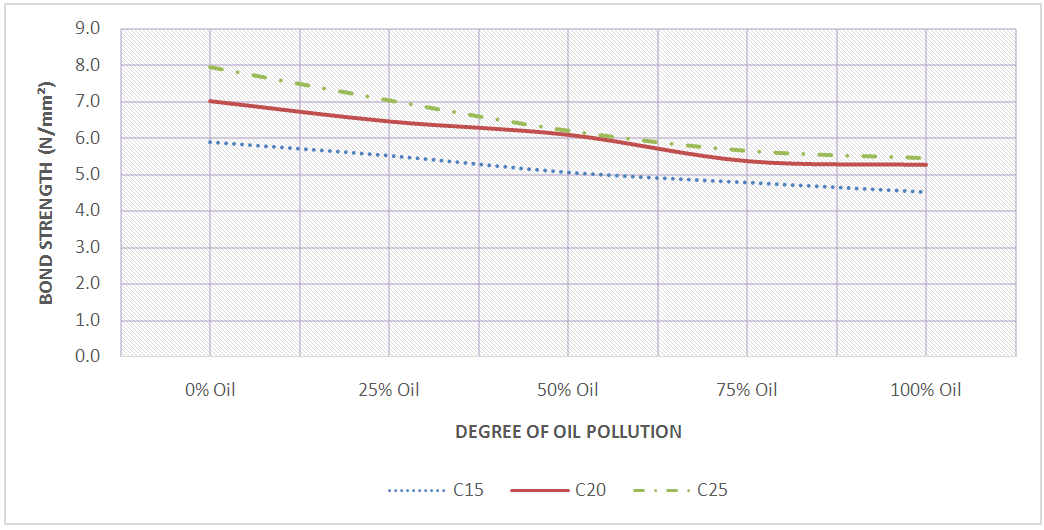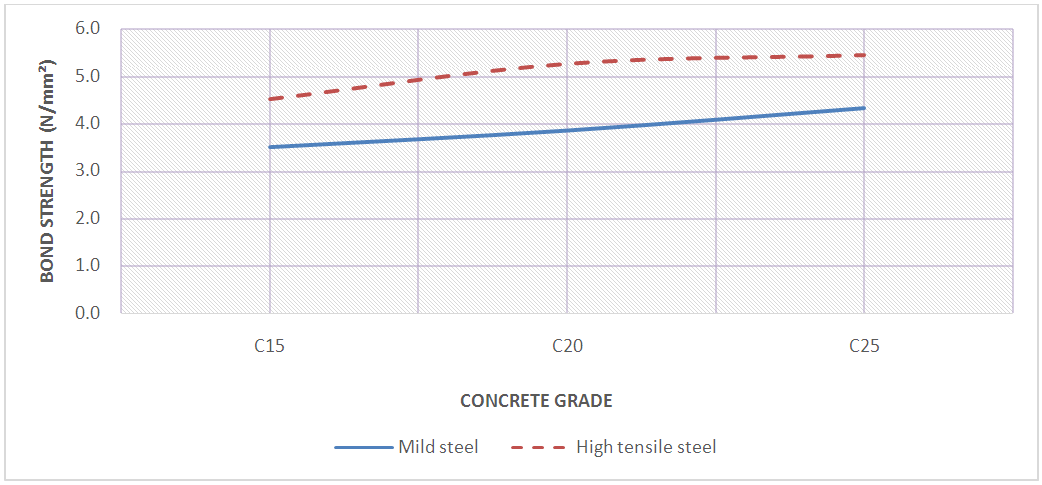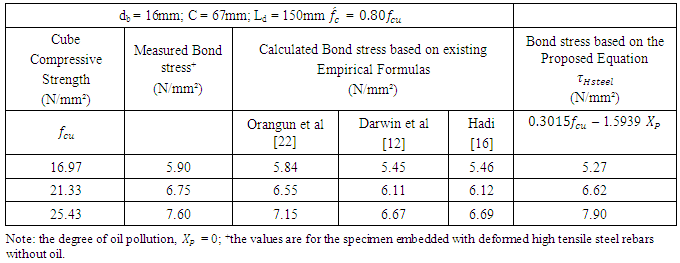-
Paper Information
- Paper Submission
-
Journal Information
- About This Journal
- Editorial Board
- Current Issue
- Archive
- Author Guidelines
- Contact Us
International Journal of Construction Engineering and Management
p-ISSN: 2326-1080 e-ISSN: 2326-1102
2017; 6(3): 94-102
doi:10.5923/j.ijcem.20170603.04

Modelling the Bond Strength of Reinforced Concrete with Oil Polluted Rebars
Eric Boateng, Anthony K. Danso, Joshua Ayarkwa
Department of Building Technology, College of Art and Built Environment, Kwame Nkrumah University of Science and Technology, Kumasi, Ghana
Correspondence to: Anthony K. Danso, Department of Building Technology, College of Art and Built Environment, Kwame Nkrumah University of Science and Technology, Kumasi, Ghana.
| Email: |  |
Copyright © 2017 Scientific & Academic Publishing. All Rights Reserved.
This work is licensed under the Creative Commons Attribution International License (CC BY).
http://creativecommons.org/licenses/by/4.0/

The serviceability and ultimate strength of reinforced concrete structures are greatly influenced by the strength of the bond mechanism between steel and concrete. The bond ensures that the structure remains in equilibrium under any given load. Oil as a formwork releasing agent on construction sites affects this bond. This paper presents an empirical formula for estimating the bond strength of reinforced concrete with oil polluted steel rebars. The experimental programme utilized standard 150mm concrete cubes centrally embedded with either deformed high tensile steel or deformed mild steel rebars. Three (3) grades of concrete (C15, C20 & C25) were designed. Used engine oil was applied as a coating on the rebar surface at varying coverage areas. The loss in contact pressure and the decrease in friction coefficient were evaluated using tension pull-out test technique with different levels of rebar oil pollution. Multivariate regression analysis was carried out to derive the relationship between the dependent variable (bond strength) and the independent variables (degree of oil pollution and concrete compressive strength) for two grades of steel (mild and high tensile steels). The results revealed that bond strength increases with increasing compressive strength of concrete while the presence of oil reduces the bond strength.
Keywords: Bond Strength, Used Engine Oil, Reinforced Concrete, Rebars
Cite this paper: Eric Boateng, Anthony K. Danso, Joshua Ayarkwa, Modelling the Bond Strength of Reinforced Concrete with Oil Polluted Rebars, International Journal of Construction Engineering and Management , Vol. 6 No. 3, 2017, pp. 94-102. doi: 10.5923/j.ijcem.20170603.04.
Article Outline
1. Introduction
- The performance of reinforced concrete (R C) structures, as in other composite members, depends on the bond between the steel and the concrete which ensures that load is transferred safely between the two materials [16, 18]. The bond mechanism which is described by Park and Paulay [23] as a continuous stress field that develops in the vicinity of the concrete - steel interface ensures that the structure remains in equilibrium under any given load. In structures subjected to loads beyond its bond strength capacity, high deformation in the form of slip occurs between the rebar and the concrete. Thus, the serviceability and ultimate strength of R C structures is a function of the strength of the bond mechanism between concrete and steel [6, 7, 19]. Studies conducted by Darwin [13] and ACI 408R [1] revealed that forces are transferred from concrete to reinforcement in three ways: (a) chemical adhesion between the concrete and the steel (b) friction between the bar surface and the concrete and (c) bearing of the ribs against the concrete. It was further noted by ACI 408R [1] that, while load transfer through bearings depends on the geometry of the steel and the magnitude of the friction, the adhesion between steel and concrete depends on the properties of the concrete, the presence of confinement around the bar as well as the surface conditions of the bar. Based on the above, it was found that deformed steel rebars depend heavily on mechanical interlock in load transfer with the other mechanisms providing nominal support. The bearing of concrete on the steel ribs causes the mechanical interlock. In the case of plain (smooth) reinforcing bars, the absence of ribs means force transfer through mechanical interlock is almost non-existent and therefore depends primarily on the chemical adhesion and frictional resistance between the concrete and the steel to transfer load [1]. Research have shown that contaminants such as oil, rust, epoxy, concrete splatter etc. found on construction sites affect bond strength. The problems facing designers currently is how to estimate the extent of the impact of these contaminants on concrete-steel bond. In their work, Fang et al. [15] found that the corrosion increases with the bond at low corrosion levels (i.e. up to 4%) but substantially decreases the bond when corrosion increase to a higher level of around 6%. At low corrosion levels, the presence of corrosion products (rust) increase bond however, as corrosion increases to higher levels there is degradation in the diameter and rib height of the steel rebar. The corrosion product causes a volume increase and exerts expansive radial pressure at the steel–concrete interface. Hoop tensile stresses are also developed in the surrounding concrete and this phenomenon weakens bond. Auyeung et al. [5] also observed a decrease of around 8% in bond strength for unconfined corroded steel rebars with 2% diameter loss. Bond strength is also negatively affected by epoxy coating. It reduces the adhesion and friction at the concrete - steel interface [17]. The loss in bond strength is found to range from 15% to 50% depending on the thickness of the coating, bar diameter and concrete properties etc. [1, 4]. Another major contaminant is used engine oil which is commonly used on construction sites in Ghana as formwork releasing agent. Studies by Adukpo et al [2], Musa and Haido [19] and Bilal et al [8] revealed that the used engine oil negatively affected the bond. It forms a firm/layer at the concrete - steel interface which mars the gripping of the steel bars within the bond zone. The oil also affects the load deflection curve [2] [8]. In the case of corrosion, extensive works have been carried out to provide analytical and empirical formulae for estimating bond. However, there is limited work in the area of oil and bond. Thus research in this direction was considered necessary. The current study was designed to fill this gap by developing empirical formulae to assist designers in evaluating the extent of the impact of the used engine oil at the concrete - steel interface on the bond.
2. Development of the Oil Influence – Bond Strength Model
- Experimental investigations indicate that various factors control bond response and that bond strength is determined by the deterioration of concrete within the vicinity of the concrete-steel interface. This suggests that bond strength of concrete can be defined in terms of its strength. Moreover, since bond failures occur by the crushing or splitting of concrete, it is rational to define bond strength in terms of the split tensile, shear and compressive strengths of concrete [21]. Thus, any attempt to develop a model for the effect of oil on bond should involve (1) an assessment of the impact on the strength properties of the concrete and (2) evaluation of the effect on the adhesion and frictional resistance at the concrete-steel interface. However, in the former case, the quantity of oil at the bond zone on a normal construction site has insignificant effect on concrete strength but considerably affect the bond strength. Hence the current model focused on the adhesion and frictional effect of the oil on the bond. The oil is hypothesized to affect bond through the formation of protective barrier between the concrete − steel interface. Consequently, force transfer through adhesion and friction is affected. The current model defined bond as a function of concrete compressive strength and the degree of oil pollution at the concrete-steel interface.
3. Materials and Methods
3.1. Study Variables
- Several variables/parameters are responsible for bond strength characterization. However, in the current model, three key variables which relate to concrete strength, rebar surface characteristics and the type of contaminant at the concrete-steel interface were studied. The independent variables were:(i) the degree of oil pollution (measured as a percentage of the embedded surface area of the rebar which is covered with the oil). Consequently, 0%, 25%, 50% 75% and 100% degrees of oil coverage/pollution on the rebar surfaces were considered. The oil type was used motor engine oil. This type of oil was chosen because it is one of the common agents used for demoulding concrete from formwork at construction sites in Ghana. The oil was applied to the bars surface in the transverse direction as explained in Figures 1 and 2.(ii) bar type – deformed high tensile steel and deformed mild steel bars of 16mm diameter were used.(iii) compressive strength of concrete. This variable was chosen because it is the most significant concrete strength property which controls bond response. Three grades of concrete were designed (C15, C20, C25). The controlled variables were the embedment length and bar size. The embedment length was taken as 150mm (i.e. 9.375 times the bar diameter). The short bond length and bar size were chosen to ensure uniform stress along the bond length and also prevent the failure of the rebar when loaded.
3.2. Materials
3.2.1. Concrete
- The concrete mix ratios used are shown in Table 1. They were designed to provide 28-day compressive strengths of 15, 20, and 25 N/mm² respectively using Ordinary Portland cement (ASTM C150 Type I; Grade 32.5). The fine aggregate was medium sand while the coarse aggregate was crushed granite of 20mm nominal size. The water/cement ratio was varied between 0.5 – 0.60. The fine aggregate had low silt content of 4%. All the materials were obtained at a site in the Accra Metropolis, Ghana.
|
3.2.2. Oil
- Used engine oil with specific gravity of 0.89 was applied as a coating on the embedded bar surface at varying coverage areas as shown in Figures 1 and 2.
 | Figure 1. Bottom view |
 | Figure 2. Degrees of oil pollution (sectional view) |
 | Figure 3. Steel rebars used in the current study |
3.2.3. Steel
- Standard deformed high tensile steel and deformed mild steel rebars of 16mm diameter having the surface characteristics described in Table 2 were used. This bar size was chosen to prevent failure of the rebar when loaded. The average yield stress was 325 N/mm² and 554 N/mm² for the mild and high tensile steels rebars respectively. The reinforcing bars were free from rust and any other forms of contaminants except the oil which was applied as a coating on the bar surface.
|
3.3. Casting of Specimen
- A 150 x 150 x 150 mm steel mould was coated with de-moulding oil at the inside and placed on a flat surface. A piece of steel reinforcing bar (550mm long) which had been descaled and cleaned was coated with used engine oil over the area to be embedded with a brush to ensure uniform coverage. 30 minutes later, the coated bar was positioned in the centre of the mould and held in position by an overhead device to prevent movement. Fresh concrete was then poured into the mould in three equal layers with each layer compacted 35 times to remove any entrapped air. The top of the concrete was levelled to flush with the mould using a trowel. After 36 hours, the cubes were removed from the mould, labelled for identification purposes and cured in a trough full of potable water until the test day. In all there were 30 specimen with three (3) specimens in each test.
 | Figure 4. Geometry of the test specimen (dimensions in mm) |
|
3.4. Pull out Test Procedure
- The cubes were each inserted into a 500 kN capacity electronic tensile test machine and loaded until failure in the form of tensile splitting of the concrete or pull-out of the rebar. The failure load was then recorded. The load from the machine was distributed onto the test specimen by a steel plate at the rate of 2.5 kN/sec. For each group, the average force of the three (3) replicate specimens was used to determine the bond stress. The stress was calculated using equation 48 of BS 8110-1 [9] as shown below:
 | (1) |
 is the bond stress which is assumed to be uniform;
is the bond stress which is assumed to be uniform;  = the pull out force l = the embedment length (150mm);
= the pull out force l = the embedment length (150mm);  = the effective bar size (16mm). The test was carried out at the laboratory of the Architecture and Engineering Services Limited (AESL) in Accra, Ghana. Figures 5 and 6 show the setup of the test apparatus.
= the effective bar size (16mm). The test was carried out at the laboratory of the Architecture and Engineering Services Limited (AESL) in Accra, Ghana. Figures 5 and 6 show the setup of the test apparatus. | Figure 5. Setup of pull out test apparatus |
 | Figure 6. Schematic diagram of Pull-out test set up |
3.5. Data Analysis Method
- Multivariate regression analysis was carried out (using the data analysis tool in Microsoft Excel) to establish the correlation between bond strength (the dependent variable) and the independent variables (i.e. degree of oil pollution and concrete compressive strength). Bond strength of concrete was defined in terms of its compressive strength
 and the degree of oil pollution
and the degree of oil pollution  as follows:
as follows: | (2) |
 and
and  are constants determined from the regression analysis.
are constants determined from the regression analysis.4. Results and Discussion
4.1. Empirical Bond Strength Model
- Figures 7, 8 & 9 show the results of the bond stresses recorded for the study. From the regression analysis carried out on the data the following relationships were gotten for bond strength of reinforced concrete with oil polluted rebars in terms of the cube compressive strength of concrete and the degree of oil pollution:
 | (3) |
 | (4) |
 | Figure 7. Effect of Oil on Bond for specimen embedded with Mild steel rebars |
 | Figure 8. Effect of Oil on Bond for specimen embedded with High Tensile steel rebars |
 | Figure 9. Comparison of the Bond strength for specimen embedded with High tensile steel with those with Mild steel rebars (100% rebar pollution) |
 results in 0.2699 N/mm² and 0.3105 N/mm² increase in the bond for the specimens embedded with mild steel and high tensile steel rebars respectively. This finding also agrees with Elighehausen et al [14], who noted that bond strength increases with an increase in compressive strength of concrete.The reliability of the above models were assessed on the basis of the Integral Absolute Error (IAE, %) technique. This index is used to determine the goodness of fit of a proposed model by measuring the absolute deviations of a data from the regression model. It is calculated as follows [20]:
results in 0.2699 N/mm² and 0.3105 N/mm² increase in the bond for the specimens embedded with mild steel and high tensile steel rebars respectively. This finding also agrees with Elighehausen et al [14], who noted that bond strength increases with an increase in compressive strength of concrete.The reliability of the above models were assessed on the basis of the Integral Absolute Error (IAE, %) technique. This index is used to determine the goodness of fit of a proposed model by measuring the absolute deviations of a data from the regression model. It is calculated as follows [20]: | (5) |
 are the observed values and
are the observed values and  the predicted values from the regression model. In practice a range of values from 0 to 10% is regarded as an acceptable value for regression equation [20]. From the analysis AIE values of 6.31% and 8.96% were recorded for the mild steel and high tensile steel models respectively confirming the reliability of the models. Moreover, the adjusted R squared values of 91.73% and 91.19% for the mild and high tensile steel models respectively show that significant variations in bond strength of reinforced concrete structures are accounted for by these models. The F values from the regression analysis were also statistically significant.
the predicted values from the regression model. In practice a range of values from 0 to 10% is regarded as an acceptable value for regression equation [20]. From the analysis AIE values of 6.31% and 8.96% were recorded for the mild steel and high tensile steel models respectively confirming the reliability of the models. Moreover, the adjusted R squared values of 91.73% and 91.19% for the mild and high tensile steel models respectively show that significant variations in bond strength of reinforced concrete structures are accounted for by these models. The F values from the regression analysis were also statistically significant.4.2. Comparison of Model Results with Existing Experimental Results
4.2.1. Adukpo et al [2]
- In this study [2] 150mm concrete cubes with 12mm deformed mild steel rebar inserts that have similar surface characteristics described in Table 2 were used. The results revealed that the average bond strength for the specimen with oil polluted rebars was 5.63 N/mm² whereas the value for those without oil was 8.26 N/mm². The
 was 29.29 N/mm². Using the model for mild steel the results can be estimated as follows:
was 29.29 N/mm². Using the model for mild steel the results can be estimated as follows: 
4.2.2. Ahmed et al [3]
- This study was carried out to assess bond behaviour and design ultimate bond stress of normal and high strength concrete. Phase I of the experiment utilized 16 mm deformed mild steel rebars with the following rib characteristics: rib height of 1.34 mm and rib spacing of 11.2 mm. The bars were centrally embedded in 150 mm concrete cubes. The cube compressive strength
 of the concrete and the 28 days Pullout test results recorded for the various specimen are shown in Fig 10. From the mild steel model
of the concrete and the 28 days Pullout test results recorded for the various specimen are shown in Fig 10. From the mild steel model  the experimental test results obtained by Ahmed et al. [3] can be predicted as follows:
the experimental test results obtained by Ahmed et al. [3] can be predicted as follows: (Note: The rebars were uncoated, i.e. 0% Oil pollution)Substituting in the values of
(Note: The rebars were uncoated, i.e. 0% Oil pollution)Substituting in the values of  the bond stresses are shown in Fig 10. From the results it can be observed that there is good agreement between the predicted values from the current model and the experimental data obtained by Ahmed et al [3].
the bond stresses are shown in Fig 10. From the results it can be observed that there is good agreement between the predicted values from the current model and the experimental data obtained by Ahmed et al [3]. | Figure 10. Comparison of Bond stress using current model with Experimental data of Ahmed et al. [3] |
4.3. Comparison between the Proposed Experimental Bond Strength Models and other Bond Strength Equations
- The measured bond strengths together with the calculated values based on the empirical formulae of Hadi [16], Orangun et al. [22], Darwin et al. [12], as well as the proposed formulae are compared. These comparisons are presented for the specimen embedded with the mild steel without oil and high tensile steel without oil in Tables 4 and 5 respectively. From each Table, it was observed once again that there was a good agreement between the proposed formulae and other existing equations in predicting the measured bond strength values from this study.
 where
where  is the cylinder compressive strength of the concrete expressed in N/mm²; this parameter is related to cube compressive strength as
is the cylinder compressive strength of the concrete expressed in N/mm²; this parameter is related to cube compressive strength as  [10]. C is the minimum concrete cover in mm;
[10]. C is the minimum concrete cover in mm;  is the size of the bar and
is the size of the bar and  is the development length.
is the development length. where C = min (Cx, Cy, Cs /2) and Cmax = max (min (Cx, Cs /2), Cy) in which Cs is the side cover, Cy is the bottom cover and Cx is the spacing between the bars.
where C = min (Cx, Cy, Cs /2) and Cmax = max (min (Cx, Cs /2), Cy) in which Cs is the side cover, Cy is the bottom cover and Cx is the spacing between the bars.
|
|
5. Conclusions and Recommendations
- This study aimed at developing an empirical formula for estimating the bond strength of reinforced concrete with oil polluted rebars. From the findings of the study was concluded that used engine oil at the interface of steel and concrete negatively affected bond through the formation of a protective layer between the two materials which impaired the gripping of the steel within the bond zone. Force transfer adhesion and frictional resistance were therefore affected. The serviceability and ultimate strength of the reinforced concrete elements were also affected. Thus the use of engine oil as formwork releasing agent on construction sites should be carefully carried out to ensure that the rebar surface is free from oil. Where the rebar is accidently soiled with the oil, steps should be taken to thoroughly clean the oil otherwise the rebar should be discarded. Moreover, where oil is used on site as formwork releasing agents, designers should allow for the possibility of some of the rebars being polluted with the oil. The design of the allowable bond strength should accommodate this in the analysis.Finally, several other variables such as embedment length and diameter of the steel rebar also affect bond response. These factors were given fixed values in the current study. It is therefore recommended that these parameters among others are included in future research programmes. More so, the current models performed quite well for concrete with compressive strength values of up to 32 N/mm² hence future studies should look at strength values beyond this limit.
 Abstract
Abstract Reference
Reference Full-Text PDF
Full-Text PDF Full-text HTML
Full-text HTML



